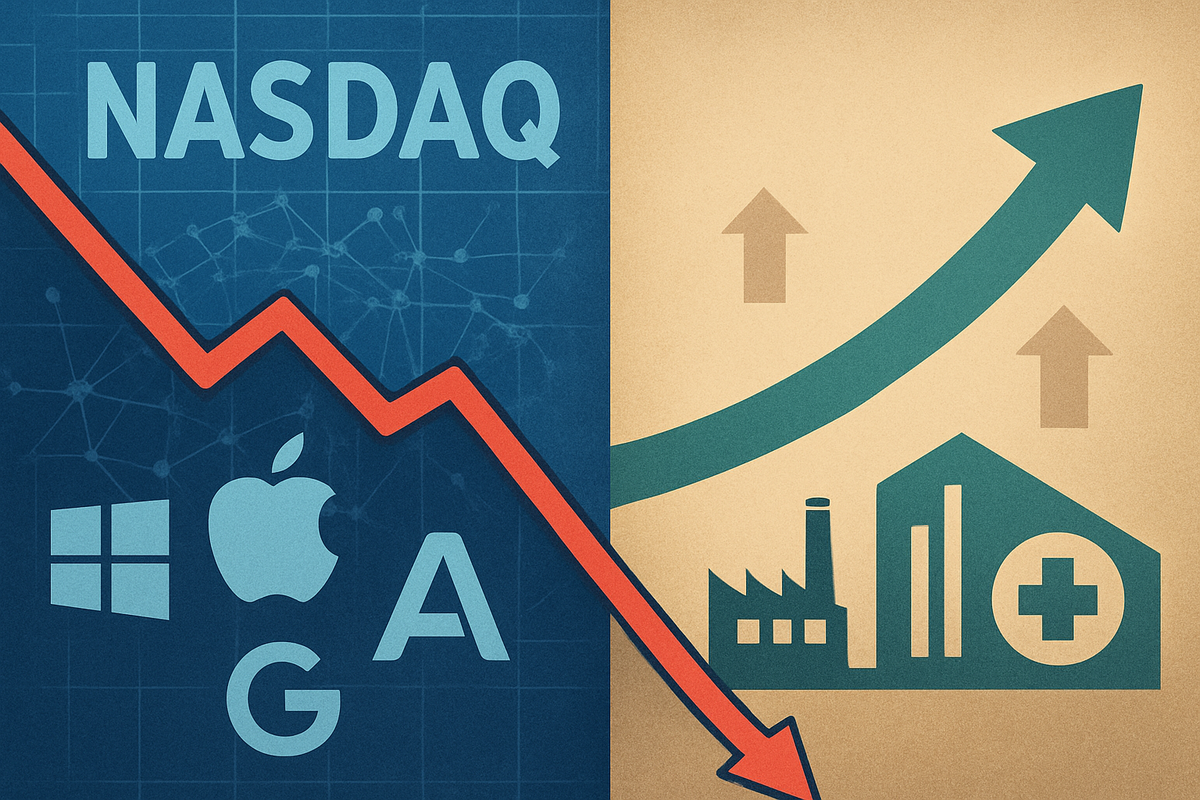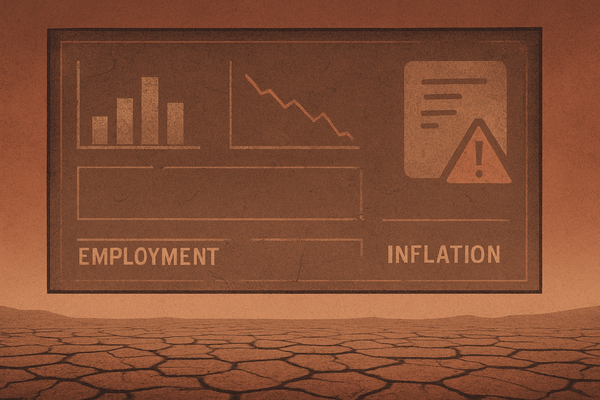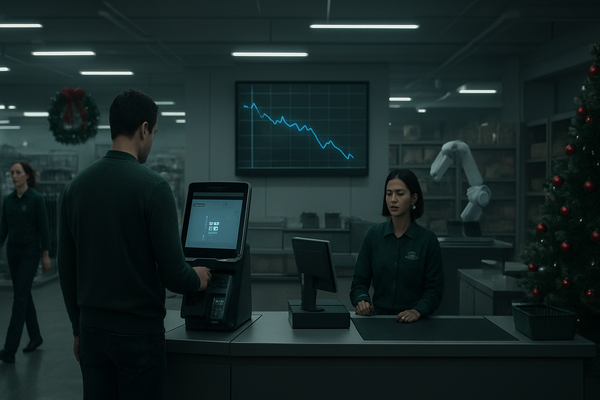Nasdaq Stumbles: Tech Sector Faces Reality Check Amid Valuation Concerns and Sector Rotation

The Nasdaq Composite (NASDAQ: IXIC) experienced back-to-back losses on November 11 and 12, 2025, signaling a significant recalibration in the financial markets. This downturn, primarily driven by growing concerns over stretched valuations in the artificial intelligence (AI) sector and a pronounced rotation of capital into more traditional industries, marks a critical re-evaluation of risk and sector leadership. While other major indices like the Dow Jones Industrial Average (DJIA) surged to record highs, the tech-heavy Nasdaq's underperformance highlights a cautious shift in investor sentiment, prompting a deeper scrutiny of high-growth technology stocks.
Unpacking the Nasdaq's Recent Retreat
The Nasdaq Composite's recent struggles are a culmination of several factors, with specific details emerging from its performance on November 11 and 12. On Tuesday, November 11, the Nasdaq Composite dipped by 0.3%, or 58.87 points, closing at 23,468.30. This occurred even as the S&P 500 (NYSEARCA: SPY) saw a modest gain of 0.2% and the Dow Jones Industrial Average (DJIA) rallied significantly by 1.2% to a new record high. Technology was the sole sector in the S&P 500 to end the day in the red. The following day, Wednesday, November 12, saw the Nasdaq Composite continue its slide, slipping an additional 0.3% to approximately 23,405.74, while the Dow Jones Industrial Average (DJIA) extended its record-setting streak, closing above 48,000 for the first time. The S&P 500 (NYSEARCA: SPY) also finished slightly higher, gaining 0.1%.
This divergence followed a period of fluctuating sentiment. A U.S. government shutdown, which began on October 1, 2025, created economic uncertainty. Throughout October, the Federal Reserve implemented two 25-basis-point interest rate cuts, bringing the range to 3.75%-4.00%, citing softer labor data. Nvidia (NASDAQ: NVDA), a bellwether for AI stocks, briefly touched a $5 trillion market capitalization. However, by early November, reports of a weakening labor market and resurfacing concerns about AI stock valuations led to a broad market downturn on November 6, with the Nasdaq Composite (NASDAQ: IXIC) falling 1.9%. A brief rebound on November 10, fueled by renewed AI enthusiasm and optimism about the government shutdown's end, was quickly overshadowed by the subsequent two-day losses.
Key players and market movers during this period included companies like Nvidia (NASDAQ: NVDA), whose stock continued to fall amid overvaluation concerns, exacerbated by SoftBank Group's (TYO: 9984) announcement of selling its entire $5.8 billion stake in the company. CoreWeave (CRWV), a cloud computing firm, saw its shares tumble after a weak annual revenue forecast, further dampening AI sentiment. Palantir Technologies (NYSE: PLTR) was noted as one of the worst-performing stocks within the Nasdaq on November 12, declining approximately 5%. Conversely, healthcare stocks like Merck (NYSE: MRK) and Amgen (NASDAQ: AMGN) led gains in the S&P 500 (NYSEARCA: SPY), and Advanced Micro Devices (NASDAQ: AMD) rallied after its CEO projected robust AI spending growth. The U.S. Federal Reserve's monetary policy and the U.S. Congress's progress in ending the government shutdown also significantly influenced overall market sentiment, with optimism about the shutdown's resolution buoying broader indices.
The Winners and Losers in a Shifting Landscape
The Nasdaq's recent downturn, driven by concerns over AI valuations and a broader sector rotation, is creating a clear divide between companies likely to thrive and those facing significant headwinds. The market's re-evaluation of risk is particularly impacting the high-growth tech sector, while traditional and defensive industries are gaining favor.
Companies highly exposed to the AI boom are feeling the most pressure. Tech giants like Nvidia (NASDAQ: NVDA), Palantir Technologies (NYSE: PLTR), Oracle (NYSE: ORCL), Advanced Micro Devices (NASDAQ: AMD), Microsoft (NASDAQ: MSFT), Alphabet (NASDAQ: GOOGL), Amazon (NASDAQ: AMZN), Apple (NASDAQ: AAPL), Meta Platforms (NASDAQ: META), and Tesla (NASDAQ: TSLA), which have seen their valuations soar on AI optimism, are experiencing substantial stock price declines. Investors are reassessing their "priced for perfection" equities, demanding tangible returns on massive AI investments. These companies may need to re-evaluate aggressive AI expansion strategies, diversify revenue streams, and potentially slow down capital expenditures in AI infrastructure. Smaller, speculative AI startups with unproven business models are particularly vulnerable, facing challenges in securing funding and retaining investor confidence. Cloud providers heavily reliant on a few large AI clients, such as Oracle's (NYSE: ORCL) deal with OpenAI, also face risks if those clients scale back.
Conversely, defensive sectors are emerging as potential winners as investors seek safe havens. Consumer Staples, including companies like Walmart (NYSE: WMT), Procter & Gamble (NYSE: PG), and Coca-Cola (NYSE: KO), are expected to see stable demand. Healthcare companies like pharmaceutical firms and medical device manufacturers, and Utilities providers of electricity and gas, are also likely to demonstrate resilience. These sectors offer relative stability or modest appreciation as capital rotates out of high-growth tech.
Value and Cyclical Sectors are also benefiting from this rotation. Financials, such as banks and insurance companies, often thrive in stabilizing economic conditions. Energy companies like ExxonMobil (NYSE: XOM) and Chevron (NYSE: CVX) can perform well if commodity prices remain firm. Industrials and Materials producers, including companies like Caterpillar (NYSE: CAT), could see increased demand during economic expansion and infrastructure development. These sectors are attracting increased investor interest and capital inflows as their fundamentals are favorably re-evaluated against tech.
Furthermore, companies supporting foundational AI infrastructure, even if not directly involved in speculative AI development, could see continued demand. Providers of electrical systems, cooling solutions, and backup power, such as Schneider Electric (EPA: SU), Eaton (NYSE: ETN), and Caterpillar (NYSE: CAT), will remain crucial as hyperscalers continue to invest in data centers for AI computational power. Their focus on supplying essential hardware and services for data centers positions them for resilience.
A Wider Lens: Trends, Ripple Effects, and Historical Echoes
The Nasdaq's back-to-back losses, fueled by AI valuation concerns and sector rotation, represent more than just a momentary blip; they signify a critical re-evaluation of market expectations and underscore several broader industry trends. This event highlights the growing investor caution regarding the sustainability of high-flying AI stock valuations and a strategic shift towards other, potentially more stable, sectors.
This downturn fits squarely into the ongoing debate about an "AI bubble." Experts have increasingly voiced concerns about "AI euphoria" leading to overinvestment, drawing parallels to the dot-com bubble of the early 2000s. While AI is undoubtedly a transformative technology, a study revealed that 95% of 52 organizations had achieved zero return on investment despite spending billions on Generative AI. This raises questions about whether current valuations, particularly for companies like Nvidia (NASDAQ: NVDA) trading at extremely high earnings multiples, are fundamentally justified. The market is also witnessing a clear sector rotation, with capital moving away from high-growth tech into value-oriented, cyclical, or defensive sectors such as healthcare, basic materials, and financials, as seen with Home Depot's (NYSE: HD) stock advance pushing the Dow Jones Industrial Average (DJIA) to new highs.
The ripple effects of a significant tech downturn would be widespread. Within the tech sector, highly valued AI firms with speculative business models would face substantial stock price depreciation and potential struggles for survival. Companies whose business models rely on the financial health of these AI firms, such as cloud service providers and hardware manufacturers (e.g., Oracle (NYSE: ORCL), CoreWeave (CRWV)), could experience significant impacts due to interconnected investments. Outside tech, financial markets could see increased volatility and currency fluctuations, while institutional investors with substantial positions in AI companies could face losses. Broader economic impacts could include a decline in consumer confidence and spending, and potentially a rise in bankruptcies.
From a regulatory standpoint, the growing warnings about trillion-dollar AI bubbles are already intensifying scrutiny of market concentration and systemic financial risks. A Nasdaq downturn would likely accelerate efforts in antitrust investigations, potentially leading to changes in securities regulations demanding greater transparency from AI companies regarding financial fundamentals and project returns. International coordination on AI sector oversight is also expected to increase, pushing tech firms to build more robust compliance functions integrated into their innovation cycles.
Historically, comparisons to the dot-com bubble are frequent. Both periods share characteristics of immense excitement around a transformative technology, rapidly rising valuations based on future potential, and high market concentration. The "Magnificent Seven" today are often compared to the top tech leaders of the early 2000s. However, crucial differences exist. Today's AI spending is largely funded by the substantial profits and strong balance sheets of established tech leaders, unlike the debt-laden startups of the dot-com era. The current AI rally is also underpinned by tangible earnings growth and real demand for AI compute, and current valuations, while high, are generally not yet at the extreme levels seen during the dot-com bubble. Furthermore, today's regulatory environment is more developed, and the investor base includes significant institutional participation. While the immediate market correction is painful, these differences suggest that the current scenario, while volatile, may navigate a different path than the complete implosion of the early 2000s.
What Comes Next: Navigating the New Market Realities
The Nasdaq Composite's recent losses mark a pivotal moment, signaling a new phase for the tech sector and broader market. The immediate future is likely to be characterized by continued market volatility and a persistent re-evaluation of tech valuations.
In the short term, expect sustained profit-taking in high-valuation AI and growth stocks. Investors are increasingly defensive, scrutinizing companies for demonstrable profitability and sustainable business models. This will accelerate the "sector rotation" trend, with capital continuing to flow from tech-heavy indices towards more cyclical and value-oriented industries such as industrials, financials, energy, and healthcare. While this period may feel turbulent, some analysts view it as a "healthy consolidation" that could present opportunities for long-term investors to re-enter at more attractive levels. However, global economic slowdowns and elevated interest rates remain significant macroeconomic headwinds.
The long-term outlook for the tech sector, particularly in areas fueled by AI, remains largely optimistic despite the short-term turbulence. AI is widely recognized as a durable investment theme and a foundational driver of value, with strong demand for AI compute and accelerating monetization. Mega-cap tech firms with robust fundamentals are expected to maintain their leadership. While some severe market downturns, like the dot-com crash, took years for full recovery, companies with strong fundamentals historically rebound more quickly. Forecasts still suggest healthy global tech earnings growth in the coming years.
Companies will need to implement strategic pivots and adaptations. A primary focus will be on profitability and efficiency, with investors demanding clearer visibility on margins and cash flow. Tech companies may need to rein in new projects and prioritize revenue-generating initiatives. AI infrastructure specialization and integration will be key, with businesses deploying GPU-optimized clusters and integrating AI into existing workflows. Business model transformation towards simplified SaaS offerings, first-party data ecosystems, and modular architectures will enhance flexibility. Crucially, firms must balance strategic cost-cutting with innovation investment, as neglecting R&D during downturns can be detrimental to long-term growth. Customer-centricity and diversification of revenue streams will also be paramount.
Market opportunities will emerge in several areas. The core AI ecosystem, including infrastructure, advanced chip design, and data centers, will continue to see growth. Beyond AI, emerging technologies like cybersecurity, sustainable technologies (GreenTech), quantum computing, edge computing, and human-technology convergence (AR/VR, brain-computer interfaces) are identified as substantial growth engines. For investors, opportunities lie in rotating into defensive or cyclical sectors and allocating to quality fixed income and gold for portfolio diversification.
However, significant challenges persist. Lingering valuation concerns for high-growth, AI-linked equities could lead to further compression. The market concentration of "Magnificent Seven" stocks raises systemic risks. Macroeconomic headwinds, including persistent inflation and elevated interest rates, could impact business investment. Regulatory scrutiny and geopolitical risks, such as U.S.-China trade tensions, also pose challenges. Finally, the execution risk in AI remains; the market is questioning whether vast capital outlays into AI infrastructure will translate into near-term profitability. Any disappointment in AI adoption or corporate profitability could have outsized effects.
Potential scenarios and outcomes include a healthy correction and rebalancing, where overstretched AI valuations cool down, leading to more balanced economic growth. Another scenario is prolonged volatility with segmented performance, where profitable tech giants weather the storm better than more speculative AI companies. A less likely, but possible, outcome is a structural shift in market leadership, similar to the post-dot-com era, where new market leaders emerge from different sectors, and tech's share of overall market capitalization normalizes. While the long-term potential of AI remains significant, companies that strategically adapt, focus on profitability, and continue to innovate responsibly are best positioned to navigate these challenges and capitalize on emerging opportunities.
Navigating the New Economic Currents: A Comprehensive Wrap-up
The Nasdaq Composite's back-to-back losses on November 11 and 12, 2025, driven by a confluence of AI valuation concerns and a significant sector rotation, represent a pivotal moment for the financial markets. This period has underscored a growing investor caution, moving away from speculative growth towards a demand for demonstrable profitability and sustainable business models.
Key takeaways from this event include the undeniable fact that the market is actively re-evaluating the "AI euphoria." While the underlying technology and its potential are transformative, the pace of valuation growth for many AI-linked companies has outstripped immediate earnings visibility. This has triggered a "Great Sector Rotation," with capital actively shifting from high-growth tech into more traditional, value-oriented, and cyclically sensitive sectors like healthcare and industrials, which are seen as safer havens in an environment of elevated interest rates and macroeconomic uncertainty.
Assessing the market moving forward, we can expect continued volatility and a discerning eye from investors. While strong corporate earnings from major tech companies indicate robust demand for AI compute and accelerating AI monetization, the market's sentiment is adjusting. This suggests a period of valuation adjustments rather than a fundamental collapse, with a potential for more tempered growth or consolidation within the tech sector. Traditional sectors are likely to see continued interest and potentially outperform, leading to a more diversified market leadership.
The significance and lasting impact of this event lie in its potential to foster a healthier, more balanced market. Unlike the dot-com bubble, today's AI spending is largely backed by the substantial profits and strong balance sheets of established tech leaders. However, the downturn serves as a stark reminder of the risks associated with market concentration. Its lasting impact will likely be a more stringent focus on demonstrable profitability for AI ventures, especially for smaller startups, and a greater appreciation for diversified investment strategies.
For investors in the coming months, vigilance and a disciplined approach are paramount.
- Diversify Portfolios: Avoid overconcentration in speculative high-growth tech. Instead, spread investments across defensive and cyclical sectors, including healthcare (e.g., Merck (NYSE: MRK), Amgen (NASDAQ: AMGN)) and industrials (e.g., Caterpillar (NYSE: CAT)), which can offer stability and steady returns.
- Focus on Fundamentals: Prioritize companies with durable cash flow, strong pricing power, and real user demand in the AI space. Corporate profit growth, rather than just multiple expansion, will be the primary driver of performance.
- Maintain a Long-Term Perspective: Market volatility is a normal feature. Panic-selling can lead to locking in losses. Adhering to a well-diversified investment plan aligned with long-term financial objectives is crucial.
- Monitor Macroeconomic Indicators: Keep a close watch on interest rate policies from the Federal Reserve, inflation data, and broader economic growth concerns, as these factors will significantly influence sector performance and capital flows.
- Watch for Technical Levels: For those actively trading, monitoring key support and resistance levels on the Nasdaq Composite (NASDAQ: IXIC) can provide insights into potential deeper corrections or stabilization points.
This period of market adjustment highlights the dynamic interplay between technological innovation, valuation realities, and macroeconomic forces. While the long-term potential of AI remains immense, the recent downturn serves as a timely reminder of the importance of disciplined investing and a balanced approach in navigating the evolving financial landscape.
This content is intended for informational purposes only and is not financial advice



